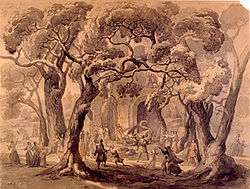Procession of Graoully
A procession with an effigy of the dragon was held in the city till the nineteenth century. It started in the eleventh century when three banners were carried in the procession of Saint Mark during Rogation days. One of these depicted a dragon's head. During the following century, an effigy of the dragon was constructed and paraded along with the banner. Later on a huge Graoully effigy was used instead of the banners. The French Renaissance writer François Rabelais described the Graoully's effigy during a procession of the sixteenth century: [2]
It was a monstrous, hideous effigy, terrifying for small children, with eyes bigger than the stomach, and a head bigger than the rest of the body, with horrific, wide jaws and lots of teeth which were made to clash by the use of a cord, making terrible noises as if the dragon of Saint Clement was actually in Metz.
The construction of the effigy continued to evolve and in the 18th century, it was constructed as a canvas figure filled with hay and twelve feet high. The jaws did not move, and the forked tongue ended with points of iron. Every baker in front of whom the procession passed, picked up a half-pound white bun and gave it to the bearer of the dragon. [1]
Symbolic representation
A number of writers have stated that the legend of the Graoully is a symbol of Christianity's victory over paganism, with Saint Clement representing religion and paganism represented by the harmful dragon.
The oldest known sculpture to date is located at 10 rue Chêvremont, on the maison du serpent, stemming from the 13th century. [5] There is also a representation of Graoully on a house in the rue de la Marne in Sarrebourg and in a room in the Château du Haut-Kœnigsbourg. [6] A depiction of Graoully from the 16th century is in the crypt in the cathedral of the Saint-Etienne. [7] Another sculpture is suspended in mid-air on Taison street, near the cathedral. The name of the Rue Taison is traced back to a warning from the Graoully: "Taisons, taisons nous, voilà le Graoully qui passe" (Be silent, here is the Graoully passing by). Supposedly Saint Clement had uttered spoken the words "taisons-nous" on his entry into the city. The Groully is also featured on the coats of arms of FC Metz. [2]
- Depictions of Graoully in Arts and Sculpture
The "Graoully" of Metz, poster of 1850, now exhibited at the Museum of Metz
Effigy of Graoully preserved in the crypt of Saint-Etienne cathedral in Metz
Copy of the effigy of the Graoully in the Lorraine room in the castle of Haut-Koenigsbourg (Bas-Rhin, France)
Graoully, procession of Saint Marc, 1631, Auguste Migette, 1846, kept in Cour d'Or museums
Printing by Auguste Migette. Representation of Saint Clement fighting the Graoully dragon in Metz's Roman amphitheater
Saint Clément, first bishop of Metz, leads the Graoully on the banks of the Seille
On the coat of arms of Sablon (neighborhood on which the amphitheater was located and where the dragon is said to have been slain), appears the heraldic representation of Graoully, pierced with the cross of Saint Clement








